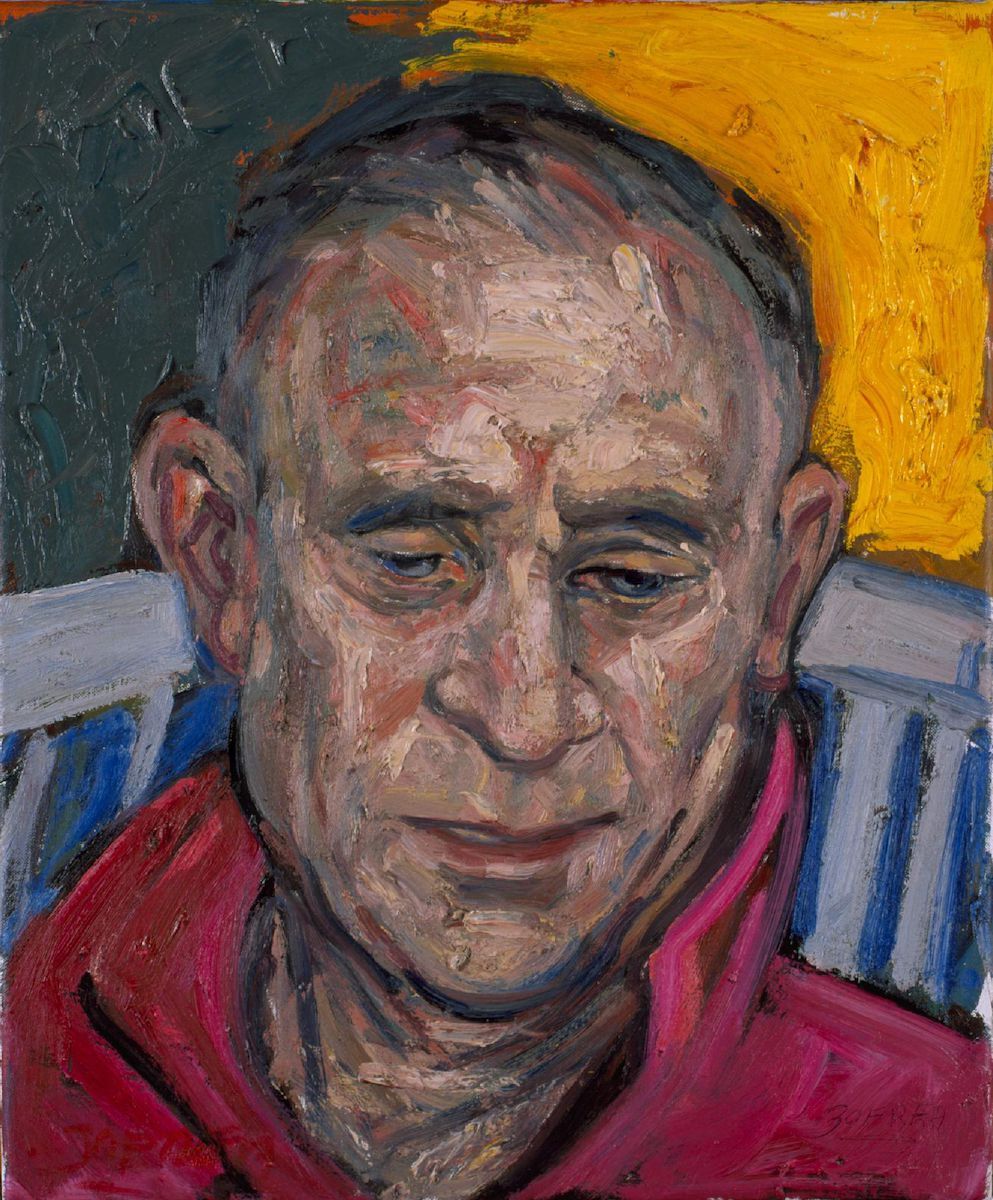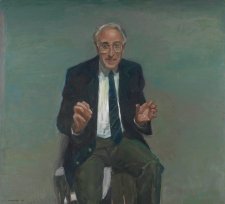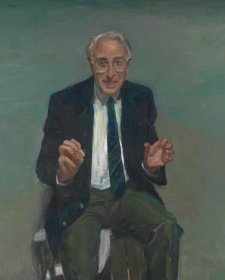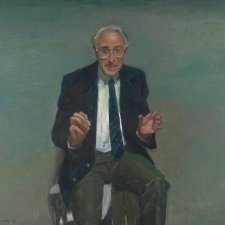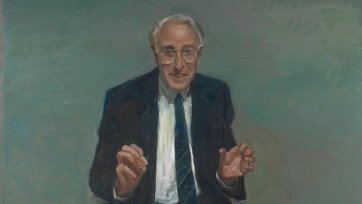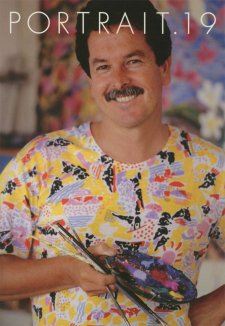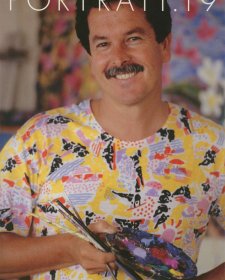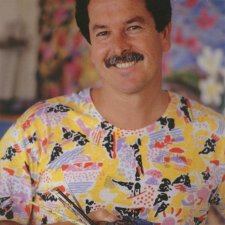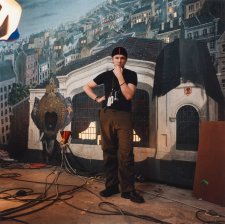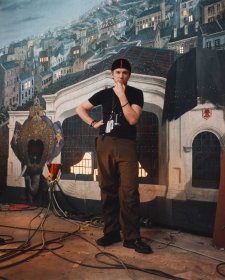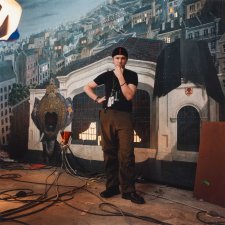'It is better to give than receive', quipped Mark Twain, 'especially advice.' Despite Twain's realistic and good humoured appraisal of humanity, the current display in the National Portrait Gallery demonstrates that people are prepared to offer their neighbours more than just words.
The nearly 100 splendid paintings, drawings and photographs in Portraits for Posterity all gifts to the Gallery, of purchases made with donated funds, testify to the generosity and community spirit of Australians.
In 1998 the first acquisitions in the fledgling collection were displayed. These first works demonstrated a preponderance of gifts that has characterised the Gallery's collecting ever since. Included in that exhibition were the first gifts of Gordon and Marilyn Darling - Clifton Pugh's 1958 portrait of Barry Humphries. This was the first of many gifts the Darlings have made to the collection, in addition to their funding of sevefal significant purchases and commissions.
The assistance of Robert Oatley and John Sctiaeffer AO in providing funds to purchase the gallery's iconic 1782 John Webber portrait of Captain James Cook in 2000 is a well known and spectacular example of the philanthropic imperative. And there have been many more donations to the Gallery since then. Indeed, shortly after he and Robert Oatley made the Cook purchase possible, John Schaeffer gave the Gallery one of the masterpieces of Australian twentieth century portraiture, George Lamberts Self-portrait with gladioli.
Artists are in a unique position in being able to offer their own work. Marea Gazzard, one of Australia's most celebrated ceramicists, is depicted in a cool blue pinafore against a background of appropriately warm earth tones by renowned portrait painter Judy Cassab, who donated the portrait. The Gallery has been fortunate in receiving significant gifts of photographs from many photographers. Juno Gemes has donated images of many of Australia's most important Indigenous activists and entertainers John Elliot maintained the focus on performers when he gave the Gallery a suite of 20 portraits including photographs of some of Australia's best known country and western singers in newcomer Casey Chambers and elder statesmen of song, Chad Morgan and Smoky Dawson. Before his death, David Moore selected over one hundred of his best portraits which were included in the National Portrait Gallery exhibition Face to Face. He gave a substantial number of these portraits to the collection, and with the assistance of Gordon Darling AC CMG and Tim Fairfax AM, the Gallery was able to purchase the remainder of this important collection. Similarly, the Gallery was able to acquire a substantial group of vintage Max Dupain portraits due to the generosity of the photographer's son. Rex Dupain and Tim Fairfax. Pat Corrigan AC donated a body of 101 photographs by Greg Weight documenting Australian artists. The portraits of Brett Whiteley, Emily Kngwarreye and Lloyd Rees offer rare insight into the lives of three individuals who gave so much to Australian culture.
Big business, often called on by cultural intuitions to support their exhibitions and programs, can also be a source of donation and the record of corporate donation to the Portrait Gallery is admirable. Alcoa World Alumina Australia recently donated a portrait of industrialist Sir Arvi Parbo 1993 by Sir William Dargie. A second portrait by Dargie, of BHP Chairman Essington Lewis, was donated by BHP 8illiton. A third painting by the artist, a portrarit of Albert Namatjira, was able to be purchased as a result of funds donated by Marilyn Darling and Philip Bacon.
Not everyone is in a position to donate a portrait directly but support can come in other forms, notably cash donation or bequest Mary Isabel Murphy assisted greatly in the commissioning of portraits of Princess Mary of Denmark by Jiawei Shen, the newest icon for the Gallery and a potential rival to Webber's James Cook for the public's attention and affection. This magnificent portrait will be the centrepiece for an exhibition of Australian portraiture assembled by the National Portrait Gallery to display in Copenhagen in April this year (see the report on the exhibition in this issue). While Mrs Murphy's legacy will be in Denmark, a second painting by Jiawei Shen, of the Hon. Tom Hughes AO QC funded by his daughter Lucy Turnbull and son-in-law Malcolm Turnbull, will maintain a strong presence for the artist. Basil Bressler's life was spent as an amateur of art. In his estate he left funds for the purchase of portraits of living artists, allowing the Gallery to successfully match artist with subject as the painting of Peter Parker by Tony Clarke, the gouache of Fred Gruen by Erwin Fabian and photograph of Norma Redpath by Mark Striae show.
Bob Edwards, retired director of touring agency Art Exhibitions Australia, donated a remarkable suite of lithographs by colonial artist and surveyor, William Henry Fernyhough who produced some of Australia's first portraits of Indigenous Australians. Like the charcoal portrait of Sydney eccentric Bee Miles by Roderick Shaw donated by Brian Griffin, they graphically illustrate that the portrait gallery represents more than just the rich and the powerful and that donors to the Gallery reflect a similar diversity.
National Portrait Gallery Director Andrew Sayers said the Gallery was delighted to receive such generous gifts, explaining that 'over 90 percent of the Portrait Gallery's Collection has been acquired through private benefaction. Our collection has been shaped by good will and that's important as this is a collection for the people of Australia and intended to be enjoyed by Australians who visit the National Portrait Gallery, for generations to come.'
The National Portrait Gallery receives substantial financial support from the Federal Government through the allocation of annual operating funds, and now with funds for the construction of a dedicated building. But support from business and the community is central to building the collection of the Gallery. Donations, bequests, gifts, grants and sponsorships from individuals, foundations, corporations and government agencies all help the National Portrait Gallery to build and maintain the Collection, as well as present programs permanent and temporary exhibitions.
